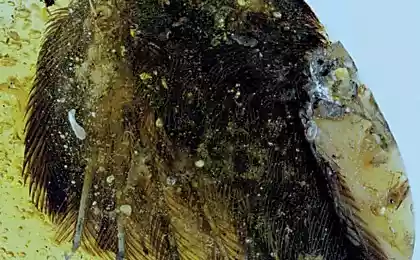906
How dinosaurs put "on their feet"
In the Far East, in the city of Blagoveshchensk is the largest and unique location of the remains of dinosaurs in Russia. In this photo essay, we will visit the paleontology laboratory of the Institute of Geology and Nature Management, Far Eastern Branch of the Russian Academy of Sciences, and learn from both found dinosaur bones collected huge skeletons that we see in museums.

Entrance into the kingdom of paleontologists.
From the first meters of doubt, where you hit, no - everywhere along the corridor are strange convolution of old newspapers and the earth, which are guessed huge bone.
This "fresh" of the dinosaurs, which scientists have to work soon.
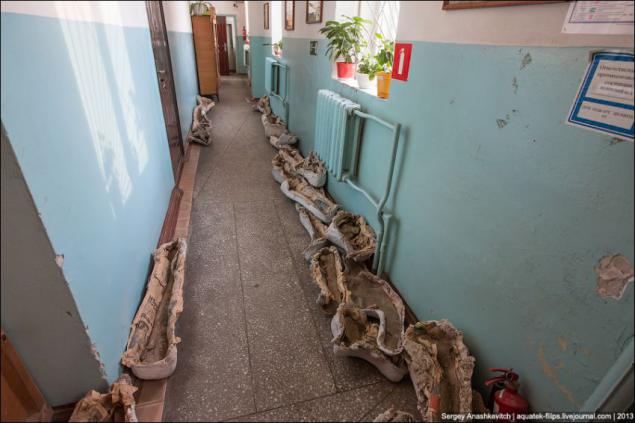
Amur Region in Russia is considered the largest parts of the dinosaur fossils located in Russia. Open it was not so long ago - at the beginning of the last century. Over time, on the basis of the location was formed paleontological laboratory, then Institute and Museum of Paleontology.
On the territory of the Annunciation and Kundurskogo localities were found unique finds - three-meter hind limb young amurosaurus, dental bone duckbilled herbivorous dinosaur, tail, neck and trunk vertebrae, ribs shlemogolovyh amurosaurus and olorotitan, Flathead kerberozavra, zauropodnogo dinosaur - arharavii and other rare even on a global scale fragments.
Skeleton oloritatana, a replica of which is the pride of the museum (see photo) is considered the most complete dinosaur skeleton found in the territory of Russia. The first part of the skeletons were discovered in 1999 during construction of the Chita-Khabarovsk highway.

This is the most extreme part of the skeleton - caudal vertebrae. It is their first in the natural articulation, builders discovered the route to spoil.
Workers could not imagine that you have found a real treasure trove for scientists.
I must say that the fragments of skeletons in the natural junction are rare and are of particular value for paleontologists because produce more accurate picture of the animal.
Excavation of the skeletons were large-scale, took an international scale and took three field seasons - 199, 2000 and 2001.
During the first field season managed dostat fragments of skeleton to the pelvis, in the second - full body and a third - round neck skull

Nahozhednie scientists believe the skull unbelievable luck, because skull allows 100% accurate to refer to a particular skeleton found described species or to open a new view.

The skeletons that we see in museums are copies and the originals of the bones are stored directly in the funds and laboratories.
This is due to the fact that for the construction of the skeleton, you must connect the pieces, drill them, glue, etc.
But first, researchers can not afford to do so with a valuable material, and secondly, very often it is very fragile and will not survive all these operations on the "construction" of the skeleton for exhibition.
It's no wonder we have seen immediately at the entrance to the laboratory these strange cocoons. These cocoons are doing right at the site, to first gently and without damage to remove a fragment of the soil, and secondly to ensure its transportation, and thirdly - temporary storage prior to the restoration and research.

A large fragment of the spine of a dinosaur in a natural articulated recently found on the whereabouts of the Annunciation, which is just in the transport cocoon.
According to the researchers, while the excavations there is always a high risk of destruction bezvovzvratnogo findings, if not properly removed. Chatso bones are rotten and can crumble right in the hands.
Therefore, when finding another bone fragment or skeleton, it is very carefully freed from the top, as far as possible from the soil particles, then the task to fix and remove them.
There are several ways - the bone is covered and sometimes impregnated with a special laminating composition, then gently draped newspapers, and then pour a plaster, or, as in the photo, with foam.

After solidification of the fixing composition of the fragment is removed and dig around.
Then it was packed in boxes, shuffle straw and transported to the laboratory.
Here in this form bones and fragments come from the excavation site.

The next step is to release the bones of fiksiruyuego cocoon and soil residues

If the bone is from a few easy pieces of glued together, and the bones themselves covered with special glue, so they do not obkrashivalis
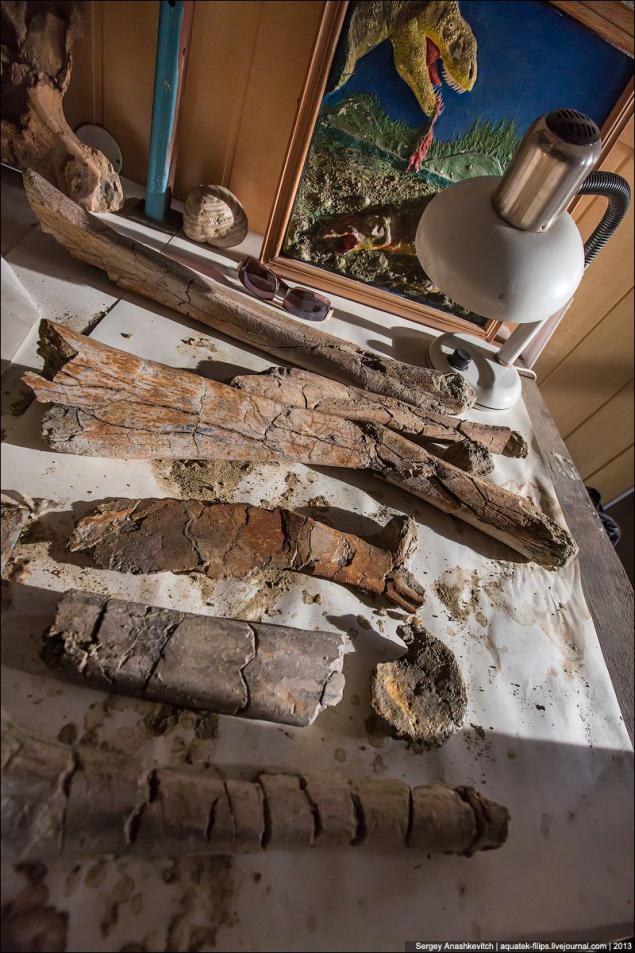
Workplace restorer. Now here is working on a fragment of the pelvis

Often the bones come in this form. Sometimes it is enough to identify their exact affiliation

Ivan Bolotsky - he is almost 15 years ago, mostly directly engaged in the extraction of the total Russian dinosaur skeleton. This man is a real enthusiast of the business, with passion and love and tells about the reality of his life - working with fossil remains in the laboratory and the expedition of.
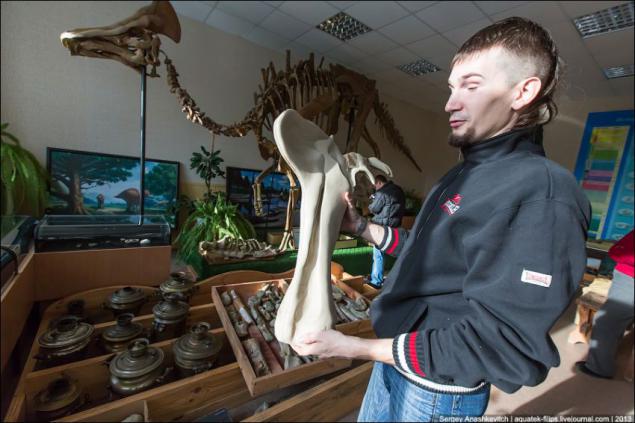
Surprisingly, he rasskazvvaet about every interesting fragments found in a given year.
For example, this carnivorous dinosaur tooth, with the bones found near the victim's body which he pierced thousands of years ago.

Once the bones are extracted from the location, transported to the laboratory and purified from the ground, they are identified, determine the status and catalog.
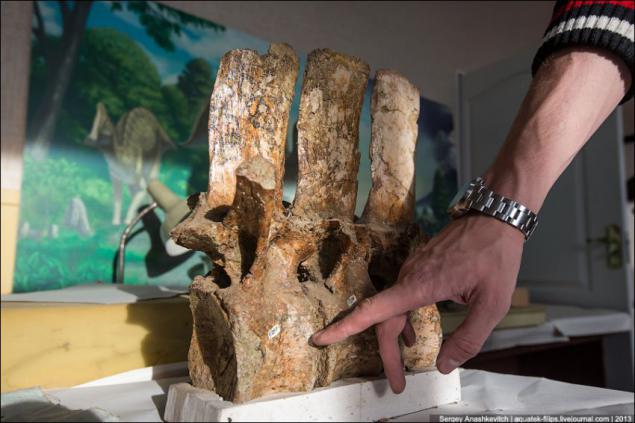
Cataloging to be absolutely all the pieces, including the bones of the

If the bones belong to the skeleton, they put in special boxes. Then, when the recovery of the entire skeleton over (and sometimes it takes a few arheologichekskih seasons), one will try to form a complete or partial skeleton. Missing bones, usually modeled

One of the skeletons unassembled

It contains a mammoth thigh. Rather, its small part)

And next - a vertebra
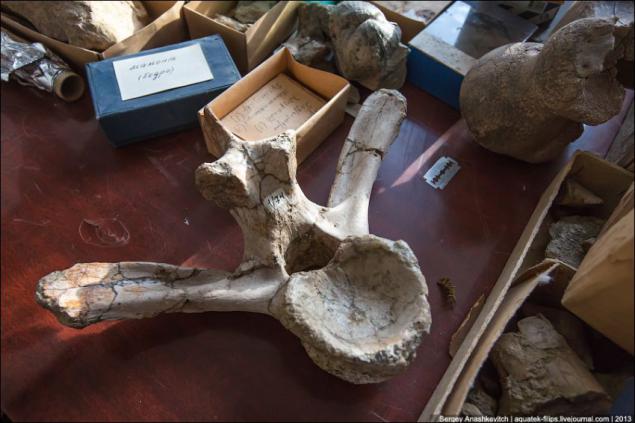
Containers with adhesive compositions, by which fix the part of the bone and cover them outside to save
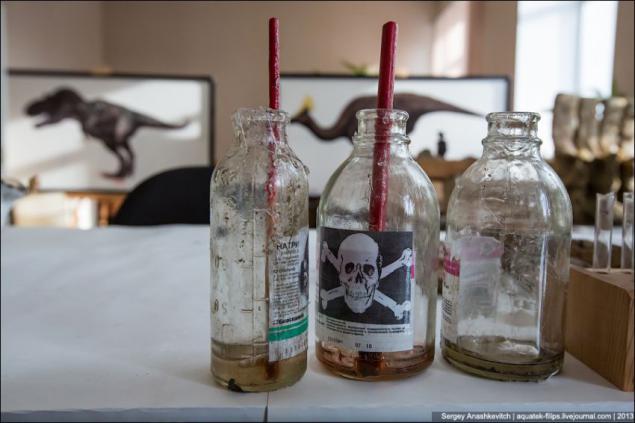
"Designer", from which through nesklko days was solid fragment

The final stage of work is the significant fragments of their compilation into a skeleton, which is then removed with accurate dimensions, and sometimes molds for manufacturing plastic replica.
Copies of the need for museum display, and for the scientists themselves to study.
After all, as I said above, the bones of the skeleton of this nobody is going out of fear of their destruction

To present fragments are applied already by plastic, gradually forming a full skeleton for exhibition.
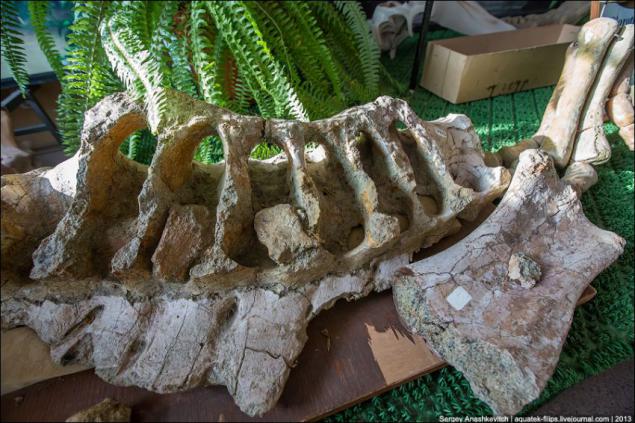
And after a while with the exact copies it will pull off the plastic covering and thousands of people will be able to witness the fruits of months of work paleontologists ...
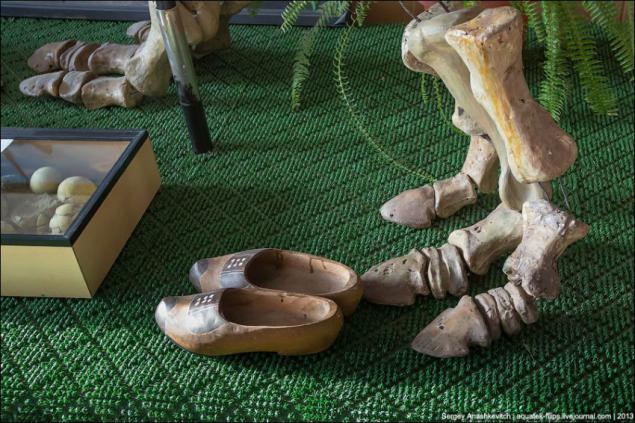
Source: aquatek-filips.livejournal.com

Entrance into the kingdom of paleontologists.
From the first meters of doubt, where you hit, no - everywhere along the corridor are strange convolution of old newspapers and the earth, which are guessed huge bone.
This "fresh" of the dinosaurs, which scientists have to work soon.

Amur Region in Russia is considered the largest parts of the dinosaur fossils located in Russia. Open it was not so long ago - at the beginning of the last century. Over time, on the basis of the location was formed paleontological laboratory, then Institute and Museum of Paleontology.
On the territory of the Annunciation and Kundurskogo localities were found unique finds - three-meter hind limb young amurosaurus, dental bone duckbilled herbivorous dinosaur, tail, neck and trunk vertebrae, ribs shlemogolovyh amurosaurus and olorotitan, Flathead kerberozavra, zauropodnogo dinosaur - arharavii and other rare even on a global scale fragments.
Skeleton oloritatana, a replica of which is the pride of the museum (see photo) is considered the most complete dinosaur skeleton found in the territory of Russia. The first part of the skeletons were discovered in 1999 during construction of the Chita-Khabarovsk highway.

This is the most extreme part of the skeleton - caudal vertebrae. It is their first in the natural articulation, builders discovered the route to spoil.
Workers could not imagine that you have found a real treasure trove for scientists.
I must say that the fragments of skeletons in the natural junction are rare and are of particular value for paleontologists because produce more accurate picture of the animal.
Excavation of the skeletons were large-scale, took an international scale and took three field seasons - 199, 2000 and 2001.
During the first field season managed dostat fragments of skeleton to the pelvis, in the second - full body and a third - round neck skull

Nahozhednie scientists believe the skull unbelievable luck, because skull allows 100% accurate to refer to a particular skeleton found described species or to open a new view.

The skeletons that we see in museums are copies and the originals of the bones are stored directly in the funds and laboratories.
This is due to the fact that for the construction of the skeleton, you must connect the pieces, drill them, glue, etc.
But first, researchers can not afford to do so with a valuable material, and secondly, very often it is very fragile and will not survive all these operations on the "construction" of the skeleton for exhibition.
It's no wonder we have seen immediately at the entrance to the laboratory these strange cocoons. These cocoons are doing right at the site, to first gently and without damage to remove a fragment of the soil, and secondly to ensure its transportation, and thirdly - temporary storage prior to the restoration and research.

A large fragment of the spine of a dinosaur in a natural articulated recently found on the whereabouts of the Annunciation, which is just in the transport cocoon.
According to the researchers, while the excavations there is always a high risk of destruction bezvovzvratnogo findings, if not properly removed. Chatso bones are rotten and can crumble right in the hands.
Therefore, when finding another bone fragment or skeleton, it is very carefully freed from the top, as far as possible from the soil particles, then the task to fix and remove them.
There are several ways - the bone is covered and sometimes impregnated with a special laminating composition, then gently draped newspapers, and then pour a plaster, or, as in the photo, with foam.

After solidification of the fixing composition of the fragment is removed and dig around.
Then it was packed in boxes, shuffle straw and transported to the laboratory.
Here in this form bones and fragments come from the excavation site.

The next step is to release the bones of fiksiruyuego cocoon and soil residues

If the bone is from a few easy pieces of glued together, and the bones themselves covered with special glue, so they do not obkrashivalis

Workplace restorer. Now here is working on a fragment of the pelvis

Often the bones come in this form. Sometimes it is enough to identify their exact affiliation

Ivan Bolotsky - he is almost 15 years ago, mostly directly engaged in the extraction of the total Russian dinosaur skeleton. This man is a real enthusiast of the business, with passion and love and tells about the reality of his life - working with fossil remains in the laboratory and the expedition of.

Surprisingly, he rasskazvvaet about every interesting fragments found in a given year.
For example, this carnivorous dinosaur tooth, with the bones found near the victim's body which he pierced thousands of years ago.

Once the bones are extracted from the location, transported to the laboratory and purified from the ground, they are identified, determine the status and catalog.

Cataloging to be absolutely all the pieces, including the bones of the

If the bones belong to the skeleton, they put in special boxes. Then, when the recovery of the entire skeleton over (and sometimes it takes a few arheologichekskih seasons), one will try to form a complete or partial skeleton. Missing bones, usually modeled

One of the skeletons unassembled

It contains a mammoth thigh. Rather, its small part)

And next - a vertebra

Containers with adhesive compositions, by which fix the part of the bone and cover them outside to save

"Designer", from which through nesklko days was solid fragment

The final stage of work is the significant fragments of their compilation into a skeleton, which is then removed with accurate dimensions, and sometimes molds for manufacturing plastic replica.
Copies of the need for museum display, and for the scientists themselves to study.
After all, as I said above, the bones of the skeleton of this nobody is going out of fear of their destruction

To present fragments are applied already by plastic, gradually forming a full skeleton for exhibition.

And after a while with the exact copies it will pull off the plastic covering and thousands of people will be able to witness the fruits of months of work paleontologists ...

Source: aquatek-filips.livejournal.com

















